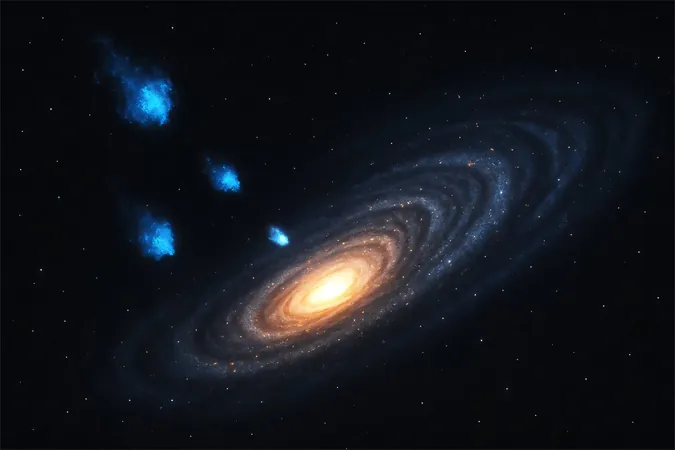
Galactic Mysteries Unveiled: M83's High-Velocity Clouds Offer a Glimpse into Galaxy Evolution
2025-07-01
Author: Yu
A Groundbreaking Discovery in the Southern Pinwheel Galaxy
Astronomers have made a stunning revelation in the Southern Pinwheel Galaxy, M83, thanks to the Atacama Large Millimeter/submillimeter Array (ALMA) Telescope. This latest study uncovered the presence of 10 high-velocity clouds made of molecular gas, moving at speeds that deviate significantly from M83's overall rotational patterns. This compelling evidence suggests that these clouds originate from outside the galaxy, potentially reshaping our understanding of star formation.
The Team Behind the Breakthrough
Led by Jin Koda, a professor at Stony Brook University, this extensive molecular gas survey included collaboration from experts like Maki Nagata and Fumi Egusa from the University of Tokyo, alongside an international team of astrophysicists. Their findings have been published in the esteemed journal, The Astrophysical Journal.
Gas: The Lifeblood of Galaxies
M83, like most galaxies, consists mainly of stars and gas, with the latter serving as the fundamental material for stellar creation. This process is essential for a galaxy’s evolution; without a steady influx of external gas, it is estimated that existing reserves would be fully consumed within approximately 1 billion years, halting star formation entirely.
M83's Secrets Might Mirror Our Milky Way
Koda emphasized the importance of their findings, stating, "Given that M83 bears resemblance to our own Milky Way, insights gleaned from this research could illuminate the mysteries of star formation and galaxy evolution in our neighborhood of the universe."
Unraveling the High-Velocity Mystery
The research team analyzed high-sensitivity molecular gas emission line data from ALMA, leading to the surprising discovery of the high-velocity molecular clouds. Nagata noted, "Most of these clouds do not correspond with known supernova remnants in M83," indicating their origins might be much more complex.
Two Competing Theories Explained
Egusa proposed two intriguing possibilities for the existence of these clouds: they could either be gas clouds that have been accreted from outside the galaxy or gas expelled by supernova explosions that eventually fall back due to gravitational forces. However, Koda highlighted a critical point, noting that the clouds' kinetic energies are too high to be solely explained by a single supernova event.
A Window into Galactic Formation
Nagata concluded, "These observations strongly suggest that many of the high-velocity clouds we see are indeed flowing into M83 from external sources." This study marks the first systematic investigation of high-velocity molecular clouds in nearby galaxies, shedding new light on the processes that influence galaxy evolution across the cosmos.






 Brasil (PT)
Brasil (PT)
 Canada (EN)
Canada (EN)
 Chile (ES)
Chile (ES)
 Česko (CS)
Česko (CS)
 대한민국 (KO)
대한민국 (KO)
 España (ES)
España (ES)
 France (FR)
France (FR)
 Hong Kong (EN)
Hong Kong (EN)
 Italia (IT)
Italia (IT)
 日本 (JA)
日本 (JA)
 Magyarország (HU)
Magyarország (HU)
 Norge (NO)
Norge (NO)
 Polska (PL)
Polska (PL)
 Schweiz (DE)
Schweiz (DE)
 Singapore (EN)
Singapore (EN)
 Sverige (SV)
Sverige (SV)
 Suomi (FI)
Suomi (FI)
 Türkiye (TR)
Türkiye (TR)
 الإمارات العربية المتحدة (AR)
الإمارات العربية المتحدة (AR)